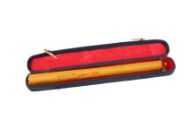Feather
Later the chief eunuch, Li Lien Ying, came dressed in his official clothes. He was one of the second rank and wore a red button and peacock feather and was the only eunuch that was ever allowed to wear the peacock feather. He was a very ugly man, very old and his face was full of wrinkles; but he had beautiful manners… [cf]
In China certain birds have symbolism associated with them. An example of this is the peacock. In Chinese symbolism, the peacock is one of the manifestations on earth of the phoenix. During the Ming dynasty the peacock represented divinity, rank, power, and beauty. Moreover, the peacock was known as the bird with a hundred eyes which is also associated with the Buddhist deity Guanyin.
Needless to say, the peacock was a very auspicious symbol. People could only wear the peacock feather on their hat if the emperor awarded them the right to do so. In practice, many officials obtained a feather by gaining favor of a high-ranking official, for example with gifts.[Cf, p112f]
There were also distinctions between peacock feathers. The three-eyed feather could only be worn by the highest ranks of the imperial family. The ranks below the imperial family could wear the two-eyed feather, and the ranks below those could wear the one-eyed feather. Officials that were not allowed to wear the peacock feathers wore feathers of other birds…
Just as we arrived I saw a number of officials talking excitedly, and some of them went into the gate shouting ‘’Li La, Doula’’ Have come, have arrived. When we got out of our chairs we were met by two eunuchs of the fourth rank [crystal button and feather]. This feather which is worn by the eunuchs of the fourth rank, comes from a bird called the magh [horse-fowl] which is found in the Szechuen province. They are grey and died black, and are much wider than the peacock feather[Cf]
Not all birds had auspicious signs associated with them as is clear from the next passage.
The eunuchs hated crows, as they are considered an unlucky bird. The people in China called eunuchs crows because they were very disagreeable. That was the reason why the eunuchs hated them so.[Cf]





